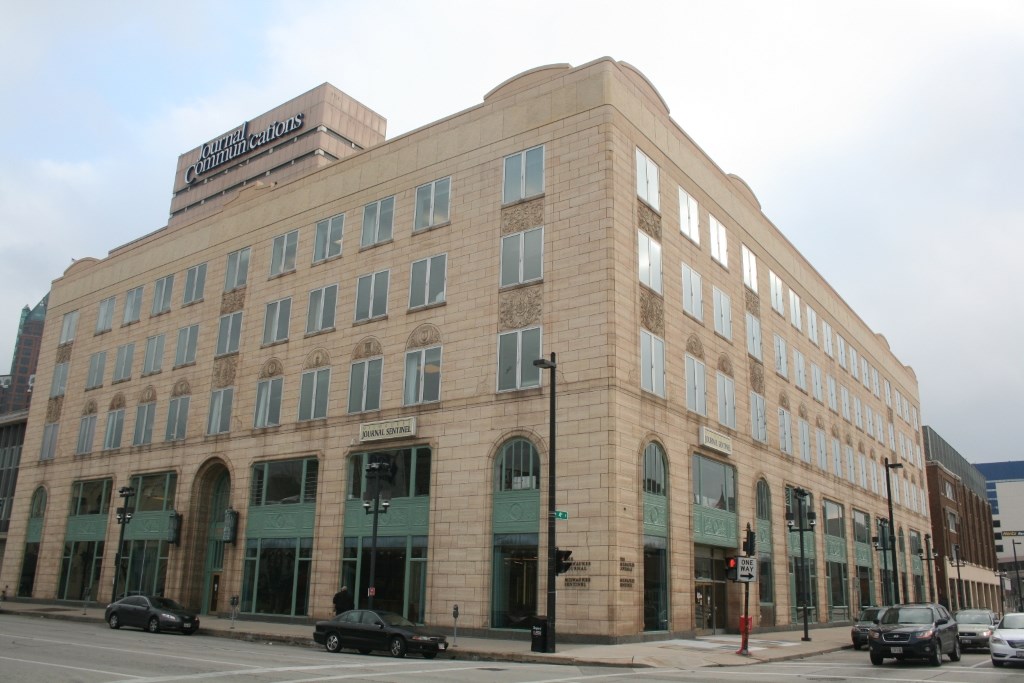Commission Deems Journal Sentinel Complex Historic
Two council members push for designation in advance of paper's possible relocation.
Milwaukee has a new historic building. Actually, a couple of them.
The Historic Preservation Commission voted unanimously Monday afternoon to approve the permanent historic designation of the entire Milwaukee Journal Sentinel complex on the block bounded by W. State St., N. Old World Third St., W. Kilbourn Ave. and W. State St.
The designation will require any future exterior changes to come before the commission for approval.
Common Council members Robert Bauman and Michael Murphy nominated the complex at 333 W. State St. for designation in early February given its potential sale.
The anchor to the complex is a six-story office building that still houses the newspaper. Built in 1924 for The Milwaukee Journal, the printing presses have been relocated to suburban West Milwaukee while an ever-shrinking reporting staff remains. A highly-decorative frieze (stone artwork wrapping the building) depicting the history of communication was removed from the building in 2011. A handful of decorative elements still remain on the facade, paying tribute to historic figures in communication and printing. City records indicate the Journal building has 256,429 square feet of space – much of it now empty.
The full-block complex, which includes a building long occupied by the Milwaukee Sentinel (918 N. Vel R. Phillips Ave.), has been listed for sale for a couple of years since the paper changed hands. Gannett, the paper’s current owner, rejected a takeover bid last month from Digital First. But Digital First, which owns almost 10 percent of Gannett already, could bid again or attempt a hostile takeover. But whether the sale goes through or not, the newspaper could find itself on the move.
The building is reported to be under contract for purchase currently by developers Joshua Jeffers and Tony Janowiec. Murphy told the commission Bauman believes that Jeffers and Janowiec don’t oppose the nomination. Jeffers did not respond to a request for comment.
Jeffers has successfully navigated the restrictions of local historic designation in the past, for buildings both old and new. Most recently the developer secured approval to build an 11-story office building at the northwest corner of N. Broadway and E. Clybourn St. in a city-designated historic district. Adjacent to that he also successfully redeveloped the Mitchell and Mackie buildings. On the other end of Downtown, the developer is pursuing a plan to develop an event space in the former St. James Episcopal Church.
Bauman, who serves on the commission, was absent from the hearing. Should the commission have needed him, he could have been found in the next room over for a meeting of the Common Council’s Judiciary and Legislation Committee.
Should it oppose the decision, Gannett still retains the right to appeal the decision to the Common Council. The national news organization did not have a representative in attendance at Monday’s hearing.
Exempt from the whole debate is the building currently occupied by Major Goolsby’s restaurant and bar. That building, owned by Gannett, is part of a different parcel.
But the parking lot in the southeast corner of the block, formerly the site of the Republic Hotel, is included in the historic designation. “There are some basic guidelines about not having a building that would engulf the Journal building,” said city historic preservation staffer Carlen Hatala about the preservation guideline document for the building.
If you want to know more about the JS complex, including its three-building, 1962 addition, how it could have supported a 42-story building, what the main JS lobby was historically used for or about that penthouse atop the building, read the extensive study prepared by Hatala.
If you think stories like this are important, become a member of Urban Milwaukee and help support real, independent journalism. Plus you get some cool added benefits.
More about the Journal Square development
- Eyes on Milwaukee: Inside the Newly Opened Journal Commons - Jeramey Jannene - Nov 15th, 2022
- Friday Photos: Journal Square Redevelopment Nears Completion - Jeramey Jannene - Jun 24th, 2022
- Eyes on Milwaukee: Jeffers, MATC Celebrate Student Housing Complex - Jeramey Jannene - Aug 17th, 2021
- Eyes on Milwaukee: Jeffers Starts Work on Second Journal Apartment Project - Jeramey Jannene - Aug 3rd, 2021
- Plats and Parcels: Journal Sentinel Complex Becoming Education Pipeline - Jeramey Jannene - Mar 28th, 2021
- Eyes on Milwaukee: Journal Sentinel Redevelopment Secures Two Environmental Cleanup Loans - Jeramey Jannene - Oct 16th, 2020
- Eyes on Milwaukee: $1 Million For ‘Really Unique Project’ - Jeramey Jannene - Jul 21st, 2020
- Eyes on Milwaukee: City Funds Get First Approval for Journal Square Lofts - Jeramey Jannene - Jul 16th, 2020
- Eyes on Milwaukee: Jeffers Advancing New Plan to Redevelop Journal Sentinel Complex - Jeramey Jannene - Jul 9th, 2020
- Eyes on Milwaukee: $6.9 Million Won for 317 Affordable Apartments - Jeramey Jannene - Apr 28th, 2020
Read more about Journal Square development here
Political Contributions Tracker
Displaying political contributions between people mentioned in this story. Learn more.
- February 13, 2016 - Robert Bauman received $100 from Joshua Jeffers
- May 7, 2015 - Robert Bauman received $386 from Tony Janowiec
Eyes on Milwaukee
-
Church, Cupid Partner On Affordable Housing
 Dec 4th, 2023 by Jeramey Jannene
Dec 4th, 2023 by Jeramey Jannene
-
Downtown Building Sells For Nearly Twice Its Assessed Value
 Nov 12th, 2023 by Jeramey Jannene
Nov 12th, 2023 by Jeramey Jannene
-
Immigration Office Moving To 310W Building
 Oct 25th, 2023 by Jeramey Jannene
Oct 25th, 2023 by Jeramey Jannene





















